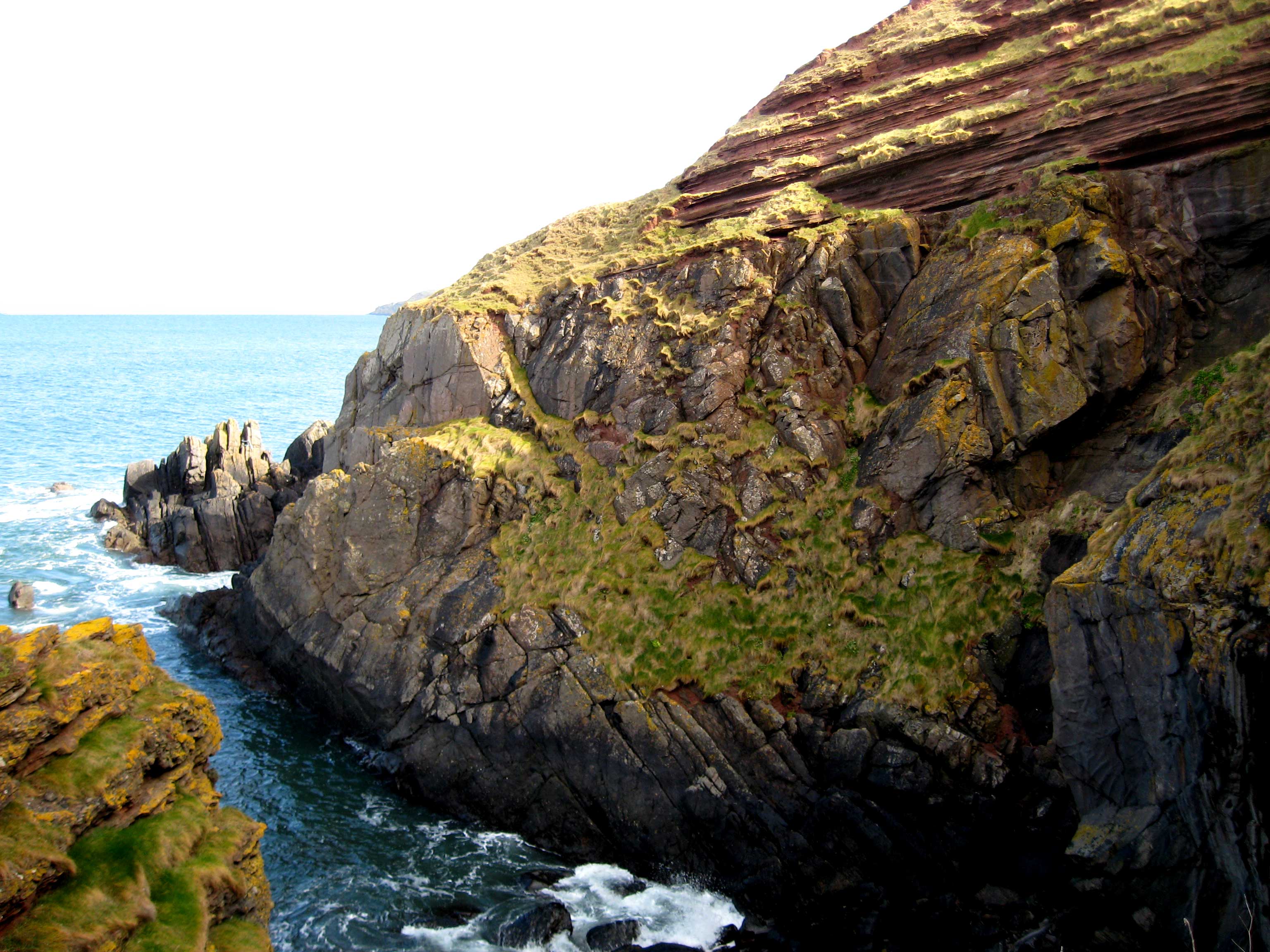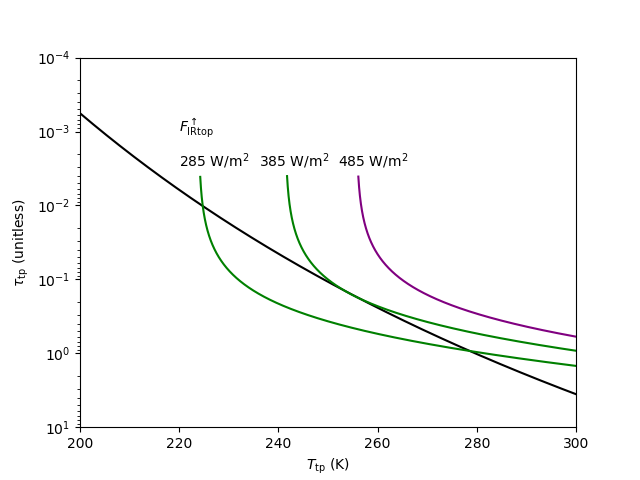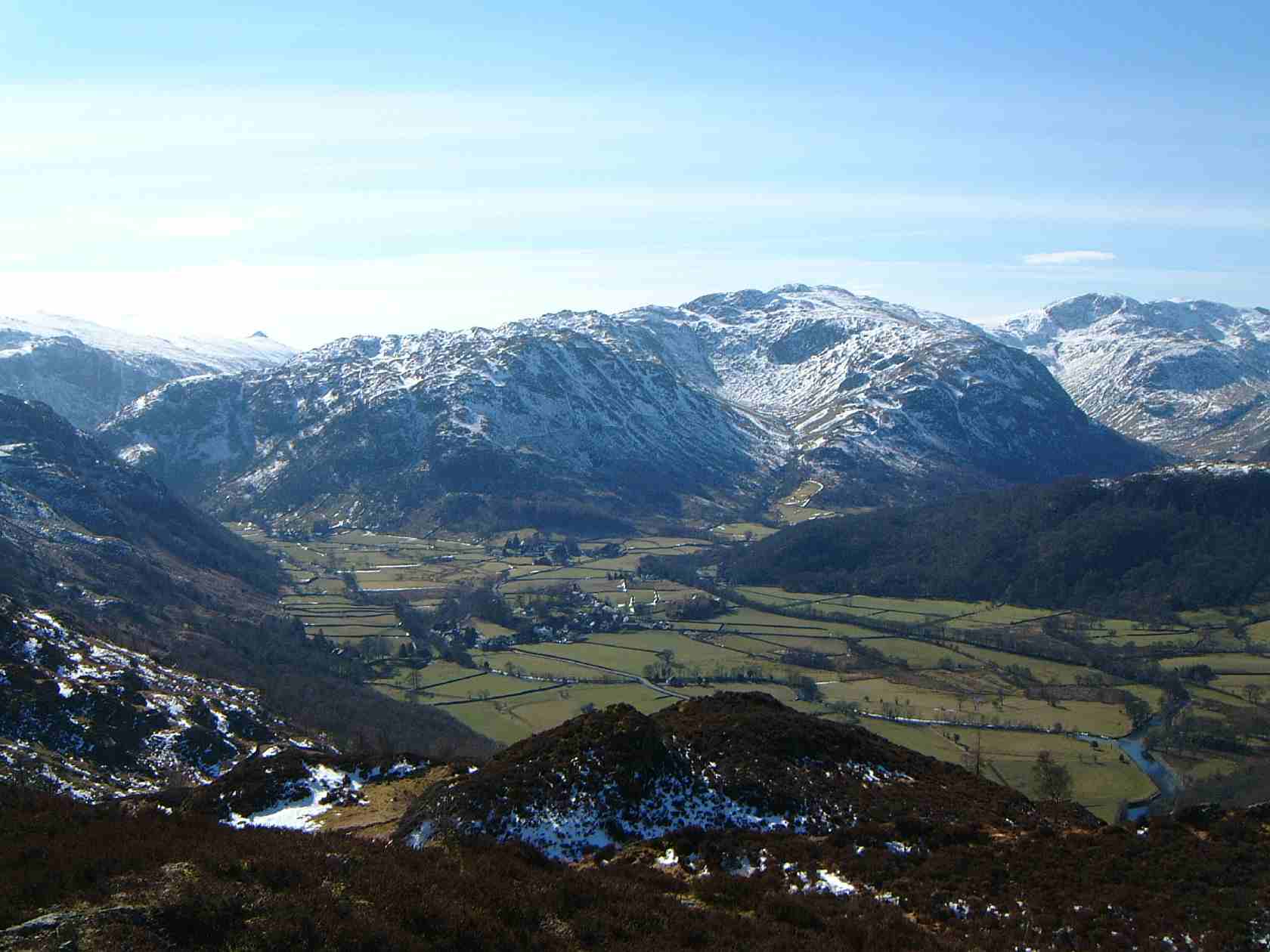|
Windermere Group (geology)
The Windermere Supergroup is a geological unit formed during the Ordovician to Silurian periods ~, and exposed in northwest England, including the Pennines and correlates along its strike, in the Isle of Man and Ireland, and down-dip in the Southern Uplands and Welsh Borderlands. It underlies much of north England's younger cover, extending south to East Anglia. It formed as a foreland basin, in a similar setting to the modern Ganges basin, fronting the continent of Avalonia as the remains of the attached Iapetus ocean subducted under Laurentia. The supergroup comprises the Dent Group of turbiditic limestones, and the overlying series of shales, grits and greywackes of the Stockdale Group, Tranearth Group, Coniston Group and Kendal Group. Compression from the south east during the later Acadian orogeny (probably caused by the closure of the Rheic ocean) buckled the strata into anticlines and synclines and caused slaty cleavage in some sediment beds. Before the Windermere: Baseme ... [...More Info...] [...Related Items...] OR: [Wikipedia] [Google] [Baidu] |
Geological Unit
A stratigraphic unit is a volume of rock of identifiable origin and relative age range that is defined by the distinctive and dominant, easily mapped and recognizable petrographic, lithologic or paleontologic features (facies) that characterize it. Units must be ''mappable'' and ''distinct'' from one another, but the contact need not be particularly distinct. For instance, a unit may be defined by terms such as "when the sandstone component exceeds 75%". Lithostratigraphic units Sequences of sedimentary and volcanic rocks are subdivided the basis of their shared or associated lithology. Formally identified lithostratigraphic units are structured in a hierarchy of lithostratigraphic rank, higher rank units generally comprising two or more units of lower rank. Going from smaller to larger in rank, the main lithostratigraphic ranks are Bed, Member, Formation, Group and Supergroup. Formal names of lithostratigraphic units are assigned by geological surveys. Units of formation or hi ... [...More Info...] [...Related Items...] OR: [Wikipedia] [Google] [Baidu] |
Coniston Group
The Coniston Group is a Silurian lithostratigraphic group (a sequence of rock strata) in the southern Lake District and north-west Pennines of northern England. The name is derived from the small town of Coniston in Cumbria. The rocks of the Group have also previously been referred to as the Coniston Grits or Coniston Grits Formation and Coniston Subgroup. The group comprises sandstones and siltstones and some laminated hemipelagites which achieve a thickness of between 1400 and 1900m. Overlain by the Bannisdale Formation of the Kendal Group and underlain by the Wray Castle Formation of the Tranearth Group The Tranearth Group is a Silurian lithostratigraphy, lithostratigraphic group (stratigraphy), group (a sequence of rock strata) in the southern Lake District and Howgill Fells of the Pennines of northern England. The name is derived from the loca ..., it is divided into several formations. These are, in ascending order (oldest first): Wray Castle, Gawthwaite, Latrigg, P ... [...More Info...] [...Related Items...] OR: [Wikipedia] [Google] [Baidu] |
Molasse
__NOTOC__ The term "molasse" () refers to sandstones, shales and conglomerates that form as terrestrial or shallow marine deposits in front of rising mountain chains. The molasse deposits accumulate in a foreland basin, especially on top of flysch-like deposits, for example, those that left from the rising Alps, or erosion in the Himalaya. These deposits are typically the non-marine alluvial and fluvial sediments of lowlands, as compared to deep-water flysch sediments. Sedimentation stops when the orogeny stops, or when the mountains have eroded flat. Stanley, Steven M., ''Earth System History'', New York: W.H. Freeman and Company, 1999, p.243 The molasse can sometimes completely fill a foreland basin, creating a nearly flat depositional surface, that nonetheless remains a structural syncline. Molasse can be very thick near the mountain front, but usually thins out towards the interior of a craton; such massive, convex accumulations of sediment are known as ''clastic wedge I ... [...More Info...] [...Related Items...] OR: [Wikipedia] [Google] [Baidu] |
Old Red Sandstone
The Old Red Sandstone is an assemblage of rocks in the North Atlantic region largely of Devonian age. It extends in the east across Great Britain, Ireland and Norway, and in the west along the northeastern seaboard of North America. It also extends northwards into Greenland and Svalbard. These areas were a part of the ancient continent of Euramerica, Euramerica/Laurussia. In Britain it is a lithostratigraphy, lithostratigraphic unit (a sequence of rock strata) to which Stratigraphy, stratigraphers accord Geological unit#Lithostratigraphic units, supergroup status and which is of considerable importance to early paleontology. For convenience the short version of the term, ORS is often used in literature on the subject. The term was coined to distinguish the sequence from the younger New Red Sandstone which also occurs widely throughout Britain. Sedimentology The Old Red Sandstone describes a suite of sedimentary rocks deposited in a variety of environments during the Devonian ... [...More Info...] [...Related Items...] OR: [Wikipedia] [Google] [Baidu] |
Illite
Illite is a group of closely related non-expanding clay minerals. Illite is a secondary mineral precipitate, and an example of a phyllosilicate, or layered alumino-silicate. Its structure is a 2:1 sandwich of silica tetrahedron (T) – alumina octahedron (O) – silica tetrahedron (T) layers. The space between this T-O-T sequence of layers is occupied by poorly hydrated potassium cations which are responsible for the absence of swelling. Structurally, illite is quite similar to muscovite with slightly more silicon, magnesium, iron, and water and slightly less tetrahedral aluminium and interlayer potassium. The chemical formula is given as , but there is considerable ion (isomorphic) substitution. It occurs as aggregates of small monoclinic grey to white crystals. Due to the small size, positive identification usually requires x-ray diffraction or SEM-EDS ( automated mineralogy) analysis. Illite occurs as an altered product of muscovite and feldspar in weathering and hydrothermal ... [...More Info...] [...Related Items...] OR: [Wikipedia] [Google] [Baidu] |
Runaway Greenhouse Effect
A runaway greenhouse effect occurs when a planet's atmosphere contains greenhouse gas in an amount sufficient to block thermal radiation from leaving the planet, preventing the planet from cooling and from having liquid water on its surface. A runaway version of the greenhouse effect can be defined by a limit on a planet's outgoing longwave radiation which is asymptotically reached due to higher surface temperatures evaporating a condensable species (often water vapor) into the atmosphere, increasing its optical depth. This positive feedback means the planet cannot cool down through longwave radiation (via the Stefan–Boltzmann law) and continues to heat up until it can radiate outside of the absorption bands of the condensable species. The runaway greenhouse effect is often formulated with water vapor as the condensable species. In this case the water vapor reaches the stratosphere and escapes into space via hydrodynamic escape, resulting in a desiccated planet. This may have ... [...More Info...] [...Related Items...] OR: [Wikipedia] [Google] [Baidu] |
Anoxic Event
Oceanic anoxic events or anoxic events ( anoxia conditions) describe periods wherein large expanses of Earth's oceans were depleted of dissolved oxygen (O2), creating toxic, euxinic (anoxic and sulfidic) waters. Although anoxic events have not happened for millions of years, the geologic record shows that they happened many times in the past. Anoxic events coincided with several mass extinctions and may have contributed to them. These mass extinctions include some that geobiologists use as time markers in biostratigraphic dating. On the other hand, there are widespread, various black-shale beds from the mid-Cretaceous which indicate anoxic events but are not associated with mass extinctions. Many geologists believe oceanic anoxic events are strongly linked to the slowing of ocean circulation, climatic warming, and elevated levels of greenhouse gases. Researchers have proposed enhanced volcanism (the release of CO2) as the "central external trigger for euxinia." British ocea ... [...More Info...] [...Related Items...] OR: [Wikipedia] [Google] [Baidu] |
Accommodation Space
Accommodation is a fundamental concept in sequence stratigraphy, a subdiscipline of geology. It is defined as the space that is available for the Deposition (geology), deposition of sediments. Accommodation space can be pictured as the volume between the actual surface and the theoretical equilibrium surface where deposition and erosion are in balance at every point. In marine environments, this equilibrium level is sea level. In marine environments, changes in accommodation on long temporal scales is mainly determined by tectonics or by changes in eustatic sea level. In fluvial environments, changes in accommodation are controlled by the Stream gradient, gradient, discharge and sediment supply. In the lower parts of river systems, the change of accommodation in the fluvial system is controlled by the changes in marine accommodation. The term is also sometimes used to described processes by which room is made for plutons to intrude country rock (geology), country rock. Refere ... [...More Info...] [...Related Items...] OR: [Wikipedia] [Google] [Baidu] |
Accretionary Wedge
An accretionary wedge or accretionary prism forms from sediments accreted onto the non-subducting tectonic plate at a convergent plate boundary. Most of the material in the accretionary wedge consists of marine sediments scraped off from the downgoing slab of oceanic crust, but in some cases the wedge includes the erosional products of volcanic island arcs formed on the overriding plate. An accretionary complex is a current (in modern use) or former accretionary wedge. Accretionary complexes are typically made up of a mix of turbidites of terrestrial material, basalts from the ocean floor, and pelagic and hemipelagic sediments. For example, most of the geological basement of Japan is made up of accretionary complexes. Materials within an accretionary wedge Accretionary wedges and accreted terranes are not equivalent to tectonic plates, but rather are associated with tectonic plates and accrete as a result of tectonic collision. Materials incorporated in accretionary wedges inc ... [...More Info...] [...Related Items...] OR: [Wikipedia] [Google] [Baidu] |
Calc-alkaline
The calc-alkaline magma series is one of two main subdivisions of the subalkaline magma series, the other subalkaline magma series being the tholeiitic series. A magma series is a series of compositions that describes the evolution of a mafic magma, which is high in magnesium and iron and produces basalt or gabbro, as it fractionally crystallizes to become a felsic magma, which is low in magnesium and iron and produces rhyolite or granite. Calc-alkaline rocks are rich in alkaline earths ( magnesia and calcium oxide) and alkali metals and make up a major part of the crust of the continents. The diverse rock types in the calc-alkaline series include volcanic types such as basalt, andesite, dacite, rhyolite, and also their coarser-grained intrusive equivalents (gabbro, diorite, granodiorite, and granite). They do not include silica-undersaturated, alkalic, or peralkaline rocks. Geochemical characterization Rocks from the calc-alkaline magma series are distinguished from rocks ... [...More Info...] [...Related Items...] OR: [Wikipedia] [Google] [Baidu] |
Borrowdale Volcanic Group
The Borrowdale Volcanic Group is a group of igneous rock formations named after the Borrowdale area of the Lake District, in England. They are Caradocian (late Ordovician) in age (roughly 450 million years old). It is thought that they represent the remains of a volcanic island arc, approximately similar to the island arcs of the west Pacific today. This developed as oceanic crust to the (present) north-west and was forced by crustal movement under a continental land-mass to the present south-east. Such forcing under, as two plates meet, is termed subduction. This land-mass has been named Avalonia by geologists. It is now incorporated into England and Wales and a sliver of North America. Geology At that time the rocks that now comprise most of Scotland (and part of the northern Irish landmass) were not attached to Avalonia. They were separated by an ocean, called the Iapetus Ocean by geologists. The line of joining, or suture, is approximately under the Solway Firth and Cheviot ... [...More Info...] [...Related Items...] OR: [Wikipedia] [Google] [Baidu] |
Skiddaw Group
''For the Skiddaw group of hills, see Skiddaw Group'' The Skiddaw Group is a group of sedimentary rock formations named after the mountain Skiddaw in the English Lake District. The rocks are almost wholly Ordovician in age ( Tremadoc through Arenig to Llanvirn epochs) though the lowermost beds are possibly of Cambrian age. This rock sequence has previously been known as the Skiddaw Slates, the Skiddaw Slates Group and the Skiddavian Series. Its base is not exposed but in its main outcrop area, it is considered to be in excess of thick though less elsewhere. It consists largely of mudstones and siltstones with subordinate wacke-type sandstones. Their main occurrence is within the northern and central fells of the Lake District, either side of the major ENE-WSW aligned Causey Pike Fault, but inliers are found at Black Combe in the south of the Lake District and at Cross Fell in the North Pennines. Stratigraphy In the Northern Fells of the Lake District, the Skiddaw Group com ... [...More Info...] [...Related Items...] OR: [Wikipedia] [Google] [Baidu] |




